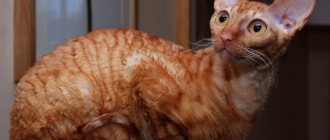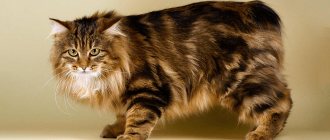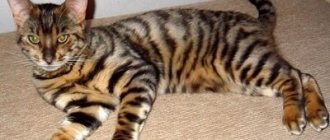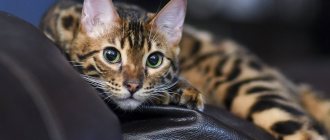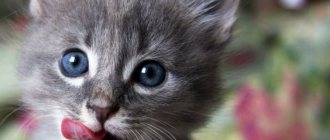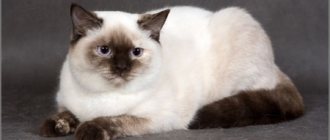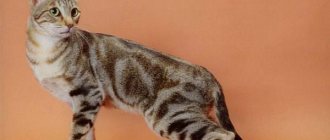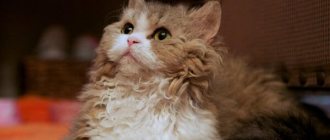Representatives of the Mekong or Thai Bobtail breed are true aristocrats among their brothers. They came to us from Asia. Ancient images have been preserved in which cats are dressed in the “decorations” of the Siamese princesses. They are similar in appearance to them in the dark color of the muzzle, but they differ from this breed - loops and kinks on the tail. The peculiarity of the animals is the similarity of their character with that of a dog: they walk on a leash, are easily taught commands and can fetch things in their teeth.
Story
The breed is one of the most ancient, and therefore there are legends and myths accompanying it.
One of them says that in ancient times beautiful princesses lived in Siamese temples and their pets were cats with broken tails and dark muzzles. While taking a bath, they took off their magnificent jewelry and put it on the tails of their guardians - Siamese with broken tails. And they took special care of their entrusted treasures.
Read a separate article about the Siamese cat breed, see their photos on our Mister Cat portal.
Representatives of this breed first came to European countries in 1884 from the capital of Siam with the poetic name City of Angels. They were brought to America several years later, and in Russia they appeared at the court of the emperor at the beginning of the 20th century.
Due to the broken tail in numerous knots, the breed was not recognized by felinologists in many countries for a long time and they were not allowed to participate in exhibitions, as this was considered a defect.
However, Russian breeders fell in love with the animals, and they made a lot of efforts to preserve the breed. At that time these animals were called Thai. By crossing the Mekong with other varieties of cats brought from Southeast Asia, it was possible to expand it.
In 1994, the Mekong standard was first adopted by the WCF, and in 2003, 30 individuals that differed significantly from the Thai Bobtail were submitted to the organization for evaluation. Based on the results, it was decided to separate these cats into a separate breed, which was called the Mekong Bobtail.
Origin story
The origin story of the Mekgonian Bobtail is as old as the world and as intricate as the Minotaur's labyrinth.
Over the years, it is impossible to establish with accuracy where on the planet their ancestors were born. But to this day, legends have been preserved telling how representatives of this breed accompanied beautiful princesses on walks, protecting the ladies from snakes, and sat next to them at important receptions. According to another myth, short-tailed cats acted as intermediaries between the worlds of the living and the dead, accompanying the soul of a deceased person to the next world. Therefore, the population of Thailand treated bobtails as sacred animals: they were settled at temples, fed with special dishes from golden plates and put to sleep on silk pillows.
In 1865, Darwin mentioned cats with a “knot for a tail” in his book on plants and animals (and even earlier, the famous commander Babur Zahireddin-Muhamed in his autobiography). For a long time, bobtails (“living gold”) were prohibited from being exported from the state under penalty of death, and only in the 19th century several dozen cats—both bobtails and Siamese, the most beautiful and intelligent—were given away to titled persons in America, Great Britain, and Europe. They also settled in the chambers of the family of Nicholas II.
For a long time, bobtails were considered a type of Siamese cat and individuals with broken and shortened tails were mercilessly culled. The breed was preserved only thanks to a few enthusiasts who were involved in maintaining the population. They began to engage in selection only in the 20th century. The first Mekong standard in the WCF was drawn up in 1994, and 10 years later, based on the results of an assessment of three dozen individuals, it was decided to distinguish the Mekong Bobtail into a separate breed.
The photo shows a Mekong Bobtail cat on a walk.
Mr. Cat recommends: character
Representatives of this breed are extremely sociable and loving, and they do not single out one person in the family, but show signs of attention to all family members.
Kittens quickly get used to their new owners. They feel comfortable living both in an apartment and in a private house. Thanks to the love for walks, you can take them with you when going out into nature and to the countryside. They can walk on a harness like dogs or run alongside without a leash.
Mekongs love to hunt and often bring dead mice or birds from walks, this is how they show their love and devotion to people.
Due to the similarity of character to dogs, they get along well with them and play, entertaining each other. Therefore, if the family already has one, you can safely get a Mekong, together they will not feel sad in the absence of their owners.
High intelligence helps in training a pet; it will easily get used to a new place of residence and quickly learn the rules accepted there. There are no problems in training to use a scratching post and a tray.
Standards
| Standard | Description |
| Head | Round, the upper part is almost flat, the features of the muzzle are smoothed, a transition is noticeable in the area of the whiskers. A profile with a transition just below eye level. Roman nose. The lower jaw is strong, like the chin, slightly protruding forward. |
| Torso | Medium size, muscular, but does not give a feeling of massiveness. Quite the opposite - slender and graceful. The back is level, only slightly rising towards the croup. |
| Paws | Neat, slender. The pads are oval. |
| Ears | Large, stand upright, but slightly laid back. The base of the ears is wide, the tips are rounded. |
| Eyes | Wide open, large, almost round in shape. The color is bright blue, slightly askew. |
| Wool | Thick and glossy, but short. Fit tightly. There is almost no undercoat. Wool feels like silk to the touch. |
| Tail | The tail of the Mekong Bobtail is its calling card, which is what makes the breed unique. It must have at least 2 vertebrae and ¼ of the body length. If these parameters are not met, the bobtail is discarded. |
Males weigh approximately 5-6 kg, females 4-5 kg.
An anatomical feature of the Mekogon Bobtail is the extraordinary plasticity of the skin. It does not fit tightly to the muscles, there are few blood vessels and nerve endings. Due to this, in the event of a snake bite, the animal most often survives - the poison spreads so slowly that the cat has time not only to finish off the enemy, but also to find a life-saving medicine among the herbs.
Kinds
There can be only one type of purebred cat according to the standard, but the colors are different. Among the Mekong, the most common options are:
- Seal point - cream color with black-brown points.
- Red (red-point), quite rare - white-pink color with “brick” (fiery red) points.
- Tortie – only found in Mekong “girls”, the highlight is that light spots are generously scattered throughout the pointing cat’s coat.
- Point chocolate (chocolate-point) – snow-white coat with dark chocolate paws, nose, ears and tail, lilac eyes.
- Blue (blue-point) – the main color is silver, the points are pink-blue.
- Tabby (black, red) - various color variations, the main thing is that the “pattern” in the form of the letter “M” on the face must be clear.
Now they are breeding golden and lilac colors, there are already good results. In addition to the Mekong, there are several other types of bobtails:
- Kuril cats are the homeland of the Kuril Islands, they have lived there for at least 200 years, they have a lot in common with Siberian cats (thick fur, some types of color, habits). The hind legs are higher than the front legs. Weight reaches 8 kg.
- Japanese - their ancestry began in the 16th century, they say that they arrived in Japan from India. They were officially registered as a breed in 1990. In Japan, they are called “hello cats” and are depicted with a raised front paw. And painters conventionally drew the tail in the form of a chrysanthemum. The coat is smooth, silky, there is little fluff, the tail looks like a “hare”. The pussy itself is very elegant in appearance.
- American ones are the only “short-tailed” species whose ancestors are precisely known and officially recognized, down to their names. Their tail looks like a brush. Some of them have tassels on their ears. The “Americans” have long hair and weigh up to 7-8 kg.
- Karelian - were bred on the territory of Karelia and Ladoga. They were created by Russian breeders, using local individuals with short tails as a basis. Perhaps their ancestors were Norwegian forest cats. The head is triangular, the eyes are rarely blue, usually lemon yellow.
Colors
Two decades ago, only 3 colors were considered officially recognized: tortie point, red point and seal point (classic Siamese).
Seal point
Seal Point (MBT n33): cream-colored coat that darkens to light brown in the mask area (muzzle), as well as on the paws, tail and ears. In this case, there should be a light spot between the ears and muzzle. The eyes are azure blue. Paw pads and nose the color of dark chocolate.
Red point
Red point (Red-point - MBT d) coat has a pale apricot color. It is brighter on the ribs and back, paler on the stomach and chest. The stripes are golden-red. The ears, tail and mask on the face are darker than the paws. A certain amount of speckling is allowed on the eyelids, lips and paw pads of individuals older than one year. Eye color – blue. The paw pads and nose are bright pink.
Torty point
Tortie point (Seal-tortie-point - MBT f) is also called tortoiseshell. Fun fact: only females have this color. And also: you will never be able to predict how your pet’s appearance will change in a year or two. The markings on the cat's body are smoothed cream in color, with ocher or reddish spots.
Blue point
Blue Point (MBT a33): the fur on the body is light blue. The nose, ears, face mask and paw pads are dark gray. Eyes – light blue. According to the standard, the presence of a small number of stripes in young animals (up to one year old) is allowed.
However, time does not stand still, just as breeders do not sit with their hands folded. Many years of work have led to the emergence of new attractive colors.
Striped colors form a separate group called tabby: tabby point, lynx point. Numerous stripes are clearly visible on the body. The color designation must be present in the name (for example, gray-blue markings - blue tabby point).
Description and features
These cats are similar in color to a Siamese or Thai cat. They are characterized by the so-called point color. That is, the whole body is of a lighter tone than its protruding parts - the muzzle with ears, paws and tail. They are colored much more intensely, for which they received the name “color point” - “color points” (from English “colored dots, marks”).
This coloring depends on temperature; warmer areas of the body produce less color pigment, so they are lighter than prominent cold ones. Blue eye color is usually associated with the point color, apparently due to the lack of melanin, both in the main color of the coat and in the iris of the eye. It turns out that the blue eyes that adorn these cats are actually colorless, the blue tint gives them the effect of light refraction.
Our cat's fur is not long, without undercoat, smooth and shiny, a little like mink fur. Moreover, the main color can be several shades: beige, cream, light gray, smoky, pink, pastel. The body is slender, graceful, but strong and muscular. The body shape is closer to rectangular, the limbs are of medium length, the “slippers” on the paws are wide.
The main feature of such an animal is a short tail. The structure of the tail is unique to each cat and is never repeated. It is all twisted, as if it had been broken and put back together for a long time. All the “fractures” are not visible under the fur, but you can feel them with your hands. There is a legend associated with this tail.
They say that the ancestors of such cats lived in the ancient temples of Siam. They were valued for their loyalty, courage, intelligence and oriental “judgment.” The Siamese courtiers protected the princesses from evil spirits, and also took care of their treasures and accompanied them everywhere, including for bathing. The girls took off their jewelry and hung it on the cats' tails, since they had a short and curved one.
Another distinctive feature is that the claws on their hind legs are not “hidden” in the pads; when walking, the cat taps them on the floor, clattering like a big dog. These creatures are very clean and take a long time to do their “toilet”. By the way, they are also capable of teaching you order.
Many Mekongs, seeing scattered toys or other things, show obvious displeasure and may begin to “scratch” this object from an inappropriate place. Better hide it in the closet right away! The character of the Mekong Bobtail can be called “golden”.
They are receptive to learning, loyal, courageous, playful. Behaviorally closer to dogs. They are even able to guard the house; when a stranger appears, they emit a “growl,” become wary, and keep him in their field of vision for a long time until he “passes the test.”
This cat can talk, you just need to learn to understand him. But he is not intrusive, not clingy like Thai cats, and with dignity draws attention to himself when he needs it. Mekongs are not fans of using their claws; they do not scratch. If you manage to anger him, he will bite you. Literally follows the owner's heels. He can even bring him things and walk him on a leash. An affectionate cat with the character of a dog.
He may well occupy himself, but he will always watch you. You are his closest friend. The cat may be left alone for a while, but do not think that he does not worry about your absence, he just has a calm disposition. The cat communicates well with small children, understands them, plays affectionately, sometimes tolerates them, but is always friendly.
The Mekong Bobtail in the photo can make you fall in love at first sight. Expressive large and slightly slanted eyes, wide ears, delicate silky fur, thick paws, a charming tail, a graceful pose - all this makes the Mekong an almost perfect creature. Each individual part is beautiful, and the whole animal so satisfies our aesthetic taste that we are involuntarily moved by looking at it.
Character and behavior
The owner's Mekong Bobtails are compared to dogs: they are so devoted to their owner that they do not leave him a single step and strive to take part in all his affairs and concerns. They don’t even mind walking the streets on a leash, and they can withstand car rides at 5 points. This is one of the most social breeds, so if the pace of life forces you to spend a lot of time on the road and you will be forced to leave the animal, get a more loyal cat.
Bobtails are affectionate and talkative, extremely active. They have an unusually developed hunting instinct. They are able to find a victim literally anywhere: be it a fly that has flown into the room, a swaying curtain, or a shadow on the wall. They are energetic and jumping: conquering an object up to half a meter high is a piece of cake for them.
They love to “talk” while sitting in the arms of the person they love. Treats children well. They are trainable, bring newspapers and slippers, and understand many words.
Representatives of this breed are very clean and do not allow themselves to shit in secluded corners of the apartment. But they won’t go into a dirty tray either: they will try with all their might to convey to you that it’s time for you to pick up a dustpan.
Which cat's smile walked on its own?
SiameseCheshire
But when it comes to “tearing up the furniture,” they are not so principled and will gladly decorate your sofa or closet with a couple of scratches. Provided that you have not equipped a special corner for such fun. They are very patient and attentive to their children, both females and males. They are good-natured and can take out someone else’s kitten. The head of the family in the cat “social unit” is always the female.
They mature early: sometimes at five months they are ready to produce offspring. There is evidence of a cat that regularly gave birth to kittens until the age of 21.
Expert opinion
Dusheba Vera Ivanovna
In 2010, she graduated from the Moscow State Academy of Veterinary Medicine named after K.I. Scriabin with honors, specializing in veterinary medicine. I regularly attend veterinary conferences, congresses, and webinars.
Bobtails are extremely curious and tend to poke their nose into every corner of the apartment. They especially like to watch what is happening outside from the window. And this is where danger lurks for them: in a fit of excitement, the animal can fall out and be seriously injured. Therefore, be sure to equip your windows with special nets.
Mekong Bobtail: character, habits
Many owners of Mekong Bobtails dote on their pets, and there are many reasons for this. By their nature, these animals have always lived among people, so they know how to tame their wild habits to please people.
Mekongs are very sociable and inquisitive: they will follow you around the house, carefully watching every step, and sometimes giving advice in their cat language.
Unlike many cats who prefer to remain mysteriously silent, Mekong Bobtails are the talkers of talkers. The timbre of their voice will help you accurately guess whether the pet is sharing good news, complaining, or talking about something sad. And if you keep up the conversation, it will become quite long.
Important! Mekong Bobtails are very sociable and do not tolerate loneliness. Try to pay more attention to your pet, be sure to talk to him.
Animals of this breed are caring parents, and they care not only for their kittens. If there are pets in the house, especially those that are smaller in size, Mekongs will try to lick them, will react to pranks and warn them against danger. The Mekong Bobtail is distinguished by this caring for others. Videos posted on the Internet show that these cats do not even touch guinea pigs, hamsters and rats.
Mekong Bobtails are selfless protectors: they can rush at a stranger who raises their voice at their beloved owner, and they will meow under the door, warning that someone is standing behind it. No dogs will be allowed near you on walks. By the way, when attacking or defending, the Mekong would rather bite its opponent than use its claws.
Cats of this breed are kind to children. They play with them with pleasure and allow themselves to be squeezed. If the pranks go too far, the Mekong will simply try to run away and hide.
Despite their natural kindness, cats of this breed are excellent hunters. They will watch their prey for a long time and patiently and will definitely catch it.
Care instructions
Although Mekong Bobtails are heroes of legends, they still do not require royal grooming. In general, it is minimal: remove excess hair, trim nails and care for teeth and ears.
Wool
Bobtails hate to be combed, and it is not required. It is enough to collect excess hair from the body with wet hands.
Claws
Nails are trimmed once a week and only on the hind legs. Bobtails are great at using a scratching post, so choose the biggest and cutest one.
In the photo, a Mekong Bobtail cat is watching the birds through the window.
Ears
The ears are wiped once every 7 days with a cotton sponge soaked in chamomile decoction or a special lotion: VETOQUINOL Otifri, Euracon Pharma GmbH OTOKLIN, Bars. No manipulations are done with the eyes.
Teeth
To keep your cat's teeth healthy for as long as possible, train him to brush regularly. Once a week, remove plaque from the fangs with a special silicone brush and cat paste (Beaphar Toothpaste, Hartz). If your cat absolutely refuses to let you brush his teeth, add TropiClean Water Additive Original gel to the water or take him to the veterinarian several times a year for laser cleaning.
How to choose a kitten
When choosing a Mekong Thai Bobtail kitten, you should rely on the following characteristics:
- the body is strong and toned;
- paws of medium size, dense;
- nose with a small hump;
- large oval-shaped eyes;
- tail with an obligatory fracture at the base.
Kittens may be white at birth; the point coloring begins to appear only at one year of age.
The kitten should be curious and playful, moderately well-fed.
This indicates that the pet is healthy.
You should purchase an animal only from nurseries with a good reputation.
Mekong Bobtail cats are considered a fairly rare breed.
Because of this, their prices are too high.
The cost depends on criteria such as the sex of the animal, the presence or absence of CSU documents, etc.
Depending on this, the price varies between 10-50 thousand rubles.
If a pet is purchased for breeding, you should take an animal with a pedigree.
If you are buying a pet for yourself, you can consider cheaper options.
Important! When purchasing a Mekong Bobtail kitten, ask the breeder for a passport with vaccinations.
Catering
Mekong Bobtails have a special diet. Meals are fractional (due to the special internal structure). They never overeat, so access to food can be unlimited.
Natural products
Bobtails are big meat eaters. Turkey, veal, rabbit, beef, lamb - they won’t refuse anything. But they don’t like chicken. Do not offer pork, quail and duck: firstly, parasites are often found in this meat, and secondly, it is too heavy for the stomach. There is no need to cook the meat: just keep it in the freezer for a day and, after taking it out, pour it over with boiling water. They give it every day.
Bobtails also eat fish. You should not give freshwater (it accumulates toxins), only seawater: pink salmon, taimen, salmon, trout, hake. The bones are removed and the pulp is stewed. It is allowed to give no more than once a week (otherwise the cat will develop kidney problems).
Be sure to add vegetable oil to your food (half a teaspoon per porridge). Fermented milk products are given 3-4 times a week. Natural yogurt, fermented baked milk, low-fat sour cream, cottage cheese, and cream are rich in calcium and are quickly absorbed. 4 times a week - one quail egg (raw, not boiled). Chicken eggs only produce the yolk.
It is advisable to give porridge every other day. Oatmeal, rolled oats, millet, rice. Many cats love liquid semolina porridge, but while it can be given to babies often, indulge adults with this delicacy only occasionally.
Vegetables will help fill the body's need for fiber and vitamins: beets, zucchini, asparagus, pumpkin, cucumbers, carrots, greens (spinach, green onions, basils, celery). They are fed to the cat every day.
Sprout wheat or oats at home. This is not difficult at all: buy seeds or a special set at a veterinary pharmacy, sow and water the seedlings. And the cat will eat it itself as needed.
The cat should have water in its bowl at a comfortable drinking temperature (not hot, but not cold) freely available and at any time of the day. Tap water cannot be poured: be sure to boil it or pass it through a purifying filter. Every morning and every evening, wash the bowl and fill it with fresh liquid.
Mekong Bobtails should not be given the following foods:
- Tea, coffee, juices, alcohol, mineral water;
- Baked goods (bread, buns, cakes, waffles, cookies);
- Ice cream, yoghurts with colored and other additives, snowballs;
- Frankfurters, sausages, sausages, ham, canned food for people;
- Fat, trimmings, bones, skin, lard;
- Seasonings, pastes and sauces;
- Potatoes, cabbage, legumes and peas;
- Milk for individuals older than 4 months.
Expert opinion
Dusheba Vera Ivanovna
In 2010, she graduated from the Moscow State Academy of Veterinary Medicine named after K.I. Scriabin with honors, specializing in veterinary medicine. I regularly attend veterinary conferences, congresses, and webinars.
When creating a menu for your favorite tailless, consider its age (kittens and adolescents need to get more calories), temperament and health problems. You cannot feed alternately natural and industrial food! It is only permissible to replace dry food with wet food from time to time, but of the same brand.
Pictured are kittens of the Mekong Bobtail breed.
Recommended food
Economy and premium feeds are poor in composition, often cause allergic reactions and are poorly digestible; you need to choose them individually. More balanced composition in super-premium and holistic foods: Innova Evo, Acana, Sanabelle, Duke's Farm.
Below are recommended premium and holistic foods; links with food names are clickable. Using them, you can, within our website, read descriptions of food and read reviews from owners of the Mekong Bobtail cat breed.
| Super premium | Super premium | Super premium |
| Vet Life | Nature Life | Arden Grande |
What to feed the Mekong Bobtail
When feeding the Mekong Bobtail, an important point must be taken into account: food can affect the color, as a rule, making it darker.
In nurseries, animals are given professional dry food that contains the necessary bioadditives. At home, it is recommended to buy food of at least premium class. Please note that food should be low in iodine and copper.
If you prefer to feed your cat natural products, then include the following in its diet:
- lean raw meat of animals and poultry (veal, beef, rabbit, duck, turkey);
Important! To avoid infection with parasites, it is better to freeze the meat (store it in the freezer for several days, and then defrost it and give it to your pet.
- boiled vegetables (except beets), which are best mixed into meat;
- raw eggs (preferably quail);
- dairy and fermented milk products.
It is strictly forbidden to introduce the following into the Mekong Bobtail diet:
- fatty meat, fried meat;
- seafood (sea fish);
- liver;
- chicken with bones and skin (you can only boneless breast);
- cheap ready-made feed;
- food from the table;
- flour products;
- cereal porridge;
- any oil.
If you introduce a new product, watch your pet's reaction. In case of allergies and intestinal disorders, it is better to immediately exclude it.
Diseases
Mekong Bobtails are healthy. No genetic pathologies have been identified in the breed. But, according to existing statistics, some diseases in bobtails are more common than others.
Calcivirosis
Calcivirosis is a viral disease that affects the oral mucosa and upper respiratory tract. Particularly susceptible to the virus are those under 2 years of age, old animals and pets with chronic diseases. The virus is transmitted by airborne droplets (by sneezing), through household items (comb, bedding, bowl, toy) and can be brought in from the street on shoes or clothing. The first symptoms appear 3-5 days after infection. The cat begins to sneeze, tears, snot and drool flow profusely, the cornea of the eyes becomes inflamed, the temperature rises and appetite disappears.
On the first day, the introduction of Vitafel serum helps, if the infection has already developed - antibiotics, anti-inflammatory drugs, immunomodulators, vitamin injections and mouth rinses.
Gingivitis
Gingivitis is inflammation of the gums of one or more teeth. Untreated disease leads to periodontal disease, tooth loss, and the spread of the inflammatory process to internal organs. The most common cause is dental plaque, which occurs due to lack of dental care and an excess of starchy foods in the diet. But sometimes it occurs due to hormonal imbalances in a young cat’s body, with the development of a cancerous tumor, concomitant diabetes mellitus, damage to the oral mucosa (scratches from bones). The bobtail develops an unpleasant odor from its mouth, its gums appear red and swollen, and blood bleeds when pressure is applied to them. The cat doesn't eat well.
The damaged tooth is removed, the wound is treated with anti-inflammatory drugs and herbal decoctions (chamomile).
Microsporia
Microsporia is extremely unpleasant. A better known name is ringworm. Spores can be picked up when interacting with another animal, while walking (from the grass) or brought home on street shoes. If treatment is not started on time, a gradually developing bacterial infection negatively affects the functioning of internal organs and claws, and the kittens may even die.
Hairless areas appear on the cat's body, the number of which gradually increases. The skin becomes inflamed, crusts and ulcers appear on it. The animal itches a lot and bites itself.
For treatment, special shampoos, sprays and ointments are used (sulfuric acid, clotrimazole, fungin, YaM ointment), and in advanced cases - oral medications.
Kidney failure
Renal failure is a severe pathology that occurs as a consequence of some other diseases (kidney damage, inflammatory processes in kidney tissue, polycystic kidney disease, tumors, pyelonephritis, unilateral hypoplasia, congenital pathologies). In some breeds it occurs in adolescence, while in bobtails it occurs more often in old age. The animal runs and plays less, drinks a lot, but rarely urinates. There may be traces of blood in the urine. Saliva noticeably leaks from the mouth, the smell of ammonia is felt, and the mucous membranes lose their brightness. The cat rejects food and quickly loses weight, its paws and chest area swell, its temperature jumps (and not only up, but also down).
Treatment: therapeutic diet, compensation for heart failure, restoration of water-salt balance, vitamin injections, hemodialysis. Prevention: take the cat for an examination annually, have urine and blood tested (for old cats - every 6 months); feed correctly.
Expert opinion
Dusheba Vera Ivanovna
In 2010, she graduated from the Moscow State Academy of Veterinary Medicine named after K.I. Scriabin with honors, specializing in veterinary medicine. I regularly attend veterinary conferences, congresses, and webinars.
If you notice changes in the animal's behavior: aggression or lethargy, refusal to eat or drink, blood in the urine or feces, a rash on the body or mucous membranes, and similar alarming phenomena, contact your veterinarian without delay. An advanced disease becomes chronic or leads to death. Self-medication is not worth it!
Vaccinations will protect your pet from a number of infections. The worms are removed first (14 days before vaccination). If the animal has a fever, fever, or teeth are changing, the procedure is postponed.
Health
Mekongians have good health, however, it is worth showing them at least once every 6 months to a veterinarian for preventive examinations and timely vaccination. Even if the pet does not go out for walks, the owner can bring the infection on his shoes and clothes.
It is worth closely monitoring the cat’s behavior; if there are any changes, you must immediately show it to the veterinarian, because this may be a sign of the onset of the disease. Do not forget that in the early stages, many pathologies are much easier to treat than in advanced stages.
The Mekong Bobtail is rightfully considered a long-liver, and remains sexually active until old age. There was a recorded case where the cat that gave birth was 22 years old, and the cat became a father at 23. Therefore, 20 years is not the limit of life.
Advantages and disadvantages
- original and interesting appearance;
- good hunters;
- character does not change with age;
- temperament is playful, affectionate;
- ease of care and maintenance;
- devotion and affection to the owner;
- sociability;
- goodwill and lack of aggression;
- cleanliness;
- mind and intellect;
- not susceptible to genetic diseases;
- good health;
- long lifespan.
- too early puberty;
- excessive activity, mobility and jumping ability;
- increased talkativeness;
- it is difficult to find a decent nursery;
- the rarity of the breed, the difficulty of finding a match for “marriage”;
- require constant attention;
- Kittens are expensive.
Reproduction and lifespan
A Mekong Bobtail cat the first signs of interest in the other sex as early as 4 months, when the first heat comes. If you want to get healthy kittens, wait until estrus 3; before that, the “girl’s” body may not be able to cope with pregnancy. A pussy that is too young cannot bear fruit. Pregnancy lasts 63 days.
Mekong Bobtail kittens are sociable and very active. They are completely “immersed” in domestic relationships. They are interested in everything, they are inquisitive. When choosing a kitten, look at its surroundings. It absorbs the atmosphere like a sponge. If the house is clean and tidy, the mother is well-groomed and calm, you can start choosing a new friend.
By the way, Mekong cats are very responsible and careful mothers during the feeding period. At this moment, they try not to let even their beloved owner near the children. But then the father will take care of the upbringing, he will give them life skills - going to the cat litter, trying new food.
And the parent only feeds and makes sure that order reigns in the upbringing. Otherwise, no one can avoid “cracks.” Still, she is the head of the family. They can produce offspring even in old age. They live up to 20-25 years.
Castration and sterilization
Castration or sterilization is necessary at the age of 10 months if mating and further production of offspring is not desirable. This will protect the animal from unnecessary hormonal surges. After the procedure, it is necessary to provide your pet with proper care:
- Dress the animal in an “Elizabethan” collar so that the cat cannot lick the seams;
- Do not feed for about 9 hours;
- Ensure peace: place in a safe place where the pet can sleep and recover from anesthesia;
- Carry out hygienic measures for the treatment and disinfection of seams;
These cats are very curious, so they are unlikely to want to sit still after the procedure; they need regular monitoring
Choosing a kitten
When choosing Thai Bobtail kittens, pay attention to such key characteristics of the breed as:
- tail with a break at the base, contains from 3 to 5 knots, up to 25% of body length;
- eyes are large, oval;
- nose with a small hump.
The health of a kitten can be judged by its fatness, willingness to play and communicate.
When accepting a new pet into the family, you need to take care of safety in advance - install mosquito nets on windows, remove poisonous plants, hide wires, keep the washing machine closed.
Care and maintenance
Caring for these cats is unpretentious:
- They need to be provided with a comfortable sleeping place, preferably not in a noisy place where the animal will not be disturbed by sharp and loud sounds;
- The bowl with food and water should always be clean; it is unacceptable to leave leftover water or food, as this can greatly harm the pet;
- The litter box should be in a quiet place, like all cats, bobtails love cleanliness and safety;
- It is important to ensure the availability of toys; representatives of the breed are very active, they like to play a lot and for a long time;
- It is also necessary to carry out regular hygiene and water procedures to maintain healthy fur, ears and claws;
Mekongs are very active, the future owner should take into account the fact that they will have to play with the pet often and a lot
Interesting Facts
- These cats have matriarchy. If you have purchased two kittens of different sexes, the owner will always be a cat. She will dominate, even if she is smaller in size.
- It is interesting that they meow only when communicating with a person; they do not make such sounds among themselves.
- Mekongs are sensitive to sharp sounds. If the TV is loud in the room and music is playing, they leave the room. Therefore, having got such a cat, you will inevitably live in peace and quiet.
- Blue-eyed cats see worse in the dark than their relatives with yellow or green eyes. They have almost no reflective pigment in the taptum (layer of the retina). Therefore, in the dark, the eyes of such pussies do not glow, reflecting the flash. You are unlikely to get the “burning eyes effect” in the photo.
- There are amazing stories when these furry friends protected their owner from a dog and even a snake. Most likely, such skills are rooted in their storied past. Mekongs are considered descendants of sacred temple cats. And they were hired there not only for their beauty and intelligence, but also for their courage. In addition, they have a peculiarity in their physique - the skin does not fit tightly to the subcutaneous tissues. Therefore, the bites of snakes, which often crawled inside the temple, fell where there were no blood vessels. Moreover, the cat itself could injure the snake with its teeth. She circled around the reptile for a long time, exhausting it, and when it lost its vigilance, it bit the neck.
